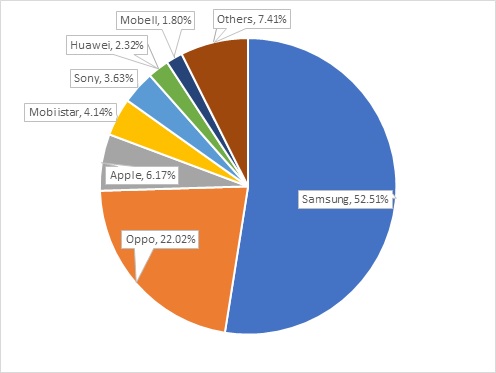With high-end smartphones like Bphone 2 or affordable smartphones like Mobiistar, will Vietnamese smartphones survive amidst the vicious competition?

New smartphones coming out one after another
Bkav just introduced Bphone 2 on August 8, two years after introducing the controversial Bphone in May 2015.
According to Do Thu Hang, director of public relations at Bkav, what set Bphone apart is that it is 100 per cent designed and manufactured in Vietnam. Bkav performed all design, including the aesthetic, electronic circuit, and mechanical design. Bkav and Vietnamese partners also manufactured the phone locally.
Bphone 2 is made of more than 900 components from hundreds of partners, with only 0.9 per cent coming from Hong Kong and China as “unimportant details.”
One of Bkav’s partners producing printed circuit boards (PCB) for Bphone 2 is Meiko Electronics Vietnam, a PCB manufacturer for many major electronic companies, such as Samsung and Apple. Meiko Electronics Vietnam is headquartered in Thach That Industrial Zone (Hanoi), along with four factories in Japan and two in China.
Also in August, Asanzo (Vietnamese TV manufacturer) is releasing its own smartphone product named Z5 below price of VND5 million ($220). The product is assembled entirely in Vietnam. Asanzo has invested in a smartphone assembly plant in Tan Binh district, Ho Chi Minh City.
Pham Van Tam, CEO of Asanzo, said that the plant can produce 600 units a day and is expected to sell 20,000 products per month.
Previously, in July 2017, VNPT Technology introduced Vivas Lotus S3 LTE. This is the fifth model in the Vivas Lotus smartphone line, with superior specs and 4G LTE support. This is the result of a long period of research and development by engineers at VNPT Technology, key company of VNPT Group in the field of research, development, and manufacturing electronic products and telecommunications technology.
According to Nguyen Trung Kien, director of the technology management and development department at VNPT Techonology, Lotus S3 LTE was developed by VNPT engineers and experts and is manufactured entirely in Hanoi.
Meanwhile, Viettel is quietly developing its first high-end smartphone product with eavesdropping prevention capability, named Viettel Luxury Phone. This smartphone is equipped with a chip developed by Viettel with many advanced security features, promising to be Viettel’s most advanced smartphone so far.
Vietnamese smartphone “graveyard”
Asides from industry giants like VNPT, Viettel, and Bkav, most Vietnamese smartphone brands failed shortly after arrival.
In 2009-2010, Q-Mobile by An Binh Telecom, Hi-mobile by HIPT, Bluefone by CMC, F series smartphones by FPT, among others, stopped manufacturing a short while after being brought out to the market.
A prime example of this is HKPhone. In June 2013, HKPhone announced it would become a Vietnamese smartphone brand offering many affordable products with high specs, competing directly with Q-mobile and Mobiistar. The company had 120 sale agents nationwide selling HKPhone. In April 2015, the company changed its name to Rovi and scaled down operations because of low sales. By the end of 2015, Rovi officially stopped manufacturing smartphones and switched to electric bikes.
According to GfK Vietnam, by the end of 2016, only Mobiistar and Masscom “survive” in the market. Mobiistar’s sales are placed 4th in Vietnam with 9 per cent of the market share and Masscom placed 5th with 5 per cent. Additionally, Mobell, a Vietnamese brand known for its affordable smartphone products, also managed to stay in the game. Their products are quite popular among low-end smartphone users in the southern region, with prices ranging from VND1.5 to 3 million ($66-132).
What is notable is that Mobiistar has survived so far thanks to the tag “Vietnamese smartphone,” attracting domestic customers, as Ngo Nguyen Kha, CEO of Mobiistar, shared.
Who will survive?
Perhaps Mobiistar survives by manufacturing affordable smartphones and aiming at young people who want a smartphone that can take nice pictures at a reasonable price.
This is different from the strategy of Bkav, VNPT or Viettel. They are attempting to step into the high-end smartphone market, which could mean direct competition with Apple, Samsung and LG.
Meanwhile, Vietnamese manufacturers’ background and mastery of technology is all behind the competition from South Korea, China or the US. Moreover, Vietnamese manufacturers are still only capable of producing their own designs, and have yet to research and develop their own smart phone technology.
A survey on the seven best-selling smartphone brands in the first half of 2017 showed that only Mobiistar is currently in the top five most popular brands in Vietnam. However, it is likely that Mobiistar will not be able to hold on to this position for long since the most popular products of Samsung and Oppo are also in the affordable segment (priced from VND4-7 million).
In the battle between smartphone brands, who will fall and who will remain is still yet to be known. The outcome is entirely up to customers.
Phan Thanh Uyen, representative of FPT Shop, said: “Most retailers support Vietnamese brands. As long as they can produce quality products with attractive designs, they will be able to survive and grow.”
VIR